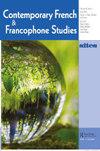The Nude, Essence and Desire: Revisiting Chinese and Western Views of the Nude with François Jullien and Giorgio Agamben
IF 0.2
4区 文学
0 LITERATURE, ROMANCE
引用次数: 0
Abstract
Abstract François Jullien believes that the pillar of Western nude art is the philosophical concepts of essence and ideal, while the benti (the Chinese counterpart of ontology) view of Chinese philosophy emphasizes change and process; therefore, it is impossible for Chinese painting to see the nude as essence. Jullien excludes works such as Chungong paintings (Chinese Spring Palace paintings) from the category of nude art because he holds that they depict nakedness, namely the process from “being dressed” to “being naked,” rather than the nude, the natural state of being naked. However, Giorgio Agamben draws on the Christian view of the nude to point out that the nude is always relative to revelation–what exists only is the state of nakedness, while the nude never exists. Nakedness is attached to “undressing,” which is endless because desire is endless. Noticeably, Agamben introduces the dimension of desire into the discussion of nude art, which has successfully created a comparative ground for Chinese and Western nude art. The sexual relationships depicted in Chungong paintings embody the Chinese view of the body and the universe, sharing a similar view in the theme of desire as in Western paintings. Thus, with the inclusion of desire, works such as Chungong paintings shall also be considered in transcultural reflections on artistic traditions between East and West.裸体、本质与欲望:与弗朗索瓦-朱利安和乔治-阿甘本一起重温中西裸体观
摘要 弗朗索瓦-朱利安认为,西方裸体艺术的支柱是本质和理想的哲学概念,而中国哲学的 "本体论 "则强调变化和过程,因此中国绘画不可能将裸体视为本质。朱利安将春宫画等作品排除在裸体艺术之外,因为他认为这些作品描绘的是裸体,即从 "着装 "到 "裸体 "的过程,而不是裸体,即裸体的自然状态。然而,乔治-阿甘本(Giorgio Agamben)借鉴了基督教的裸体观,指出裸体总是相对于启示而言的--存在的只是裸体的状态,而裸体从来就不存在。裸体依附于 "脱衣",而 "脱衣 "是无止境的,因为欲望是无止境的。值得注意的是,阿甘本在讨论裸体艺术时引入了欲望的维度,成功地为中西方裸体艺术创造了一个比较的土壤。中宫画中描绘的性关系体现了中国人的身体观和宇宙观,在欲望主题上与西方绘画有相似之处。因此,在东西方艺术传统的跨文化反思中,《春宫画》等作品也应包含欲望的内容。
本文章由计算机程序翻译,如有差异,请以英文原文为准。
求助全文
约1分钟内获得全文
求助全文
来源期刊

Contemporary French and Francophone Studies
LITERATURE, ROMANCE-
CiteScore
0.30
自引率
0.00%
发文量
43
期刊介绍:
An established journal of reference inviting all critical approaches on the latest debates and issues in the field, Contemporary French & Francophone Studies (formerly known as SITES) provides a forum not only for academics, but for novelists, poets, artists, journalists, and filmmakers as well. In addition to its focus on French and Francophone studies, one of the journal"s primary objectives is to reflect the interdisciplinary direction taken by the field and by the humanities and the arts in general. CF&FS is published five times per year, with four issues devoted to particular themes, and a fifth issue, “The Open Issue” welcoming non-thematic contributions.
 求助内容:
求助内容: 应助结果提醒方式:
应助结果提醒方式:


